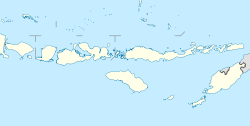Dhao language
The Dhao language, better known to outsiders by its Rotinese name Ndao (Ndaonese, Ndaundau), is the language of Ndao Island in Indonesia. Traditionally classified as a Sumba language in the Austronesian family, it may actually be a non-Austronesian (Papuan) language.[2] It was once considered a dialect of Hawu, but is not mutually intelligible. PhonologyDhao phonology is similar to that of Hawu, but somewhat more complex in its consonants.
Consonants of the /n/ column are apical, those of the /ɲ/ column laminal. /f w j/ are found in Malay loan words. In a practical orthography developed for writing the language, implosives are written ⟨b' d' j' g'⟩, the affricates ⟨bh dh⟩ (the dh is slightly retroflex), and the voiced glottal onset as a double vowel. The /ʕ/ is sometimes silent, but contrasts with a glottal stop onset in vowel-initial words within a phrase. Its phonemic status is not clear. It has an "extremely limited distribution", linking noun phrases (/ʔiki/ 'small', /ʔana ʕiki/ 'small child') and clauses (/ʕaa/ 'and', /ʕoo/ 'also'). Vowels are /i u e ə o a/, with /ə/ written ⟨è⟩. Phonetic long vowels and diphthongs are vowel sequences. The penultimate syllable/vowel is stressed. (Every vowel constitutes a syllable.) /ŋe/ [ŋe] 'this.OBJ', /neʔe/ [ˈneʔe] 'this', /ŋaŋee/ [ŋaˈŋeː] 'thinking', /ŋali/ [ˈŋali] 'senile', /ŋəlu/ [ˈŋəlːu] 'wind'. A stressed schwa lengthens the following consonant: /meda/ [ˈmeda] 'yesterday', /məda/ [ˈmədːa] 'night'. Syllables are consonant-vowel or vowel-only. f, q, v, w, x, y and z are only used in loanwords and foreign names. GrammarDhao has a nominative–accusative subject–verb–object word order, unlike Hawu. Within noun phrases, modifiers follow the noun. There are a set of independent pronouns, and also a set of pronominal clitics.
When the clitics are used for objects, there are proximal forms in the third person, ne 'this one' and si 'these', the latter also for collective plurals. When used for subjects and the verb begins with a vowel, they drop their vowel with a few irregularities:[6] keʔa meʔa neʔa teʔa ŋeʔa meʔa reʔa 'to know'. Many words that translate prepositions in English are verbs in Dhao, and inflect as such. Dhao also has a single 'intradirective' verb, laʔ 'to go', in which the clitics follow: laku lamu laʔa or laʔe lati (NA) lami lasi. Demonstratives distinguish proximal (here, now, this), distal (there, then, that), and remote (yonder, yon).
Sample clauses (Grimes (2006)).[8] ex: Lazarus (name) kako walk maɖʐutu follow nebβe shore ɖʐasi. sea 'Lazarus walked/was walking along the edge of the sea.' ex: həia then ra they kako walk taruu cont. asa PATH Baʔa. Ba’a 'Then they continued walking/traveling towards Ba’a.' Unknown glossing abbreviation(s) (help); ex: ropa when ra they poro cut r-are they-PFV kətu head na, he/his 'When they had cut off his head,' ex: te ŋaa but ra they pa-maɖʐe CAUS-die ne. this.one 'But they killed him.' ex: laɖʐe if/when ama father na he/his maɖʐe, die 'When his father dies,' ex: na he əra strong titu very kəna. much 'He was incredibly strong.' Notes
References
External links |
||||||||||||||||||||||||||||||||||||||||||||||||||||||||||||||||||||||||||||||||||||||||||||||||||||||||||||||||||||||||||||||















